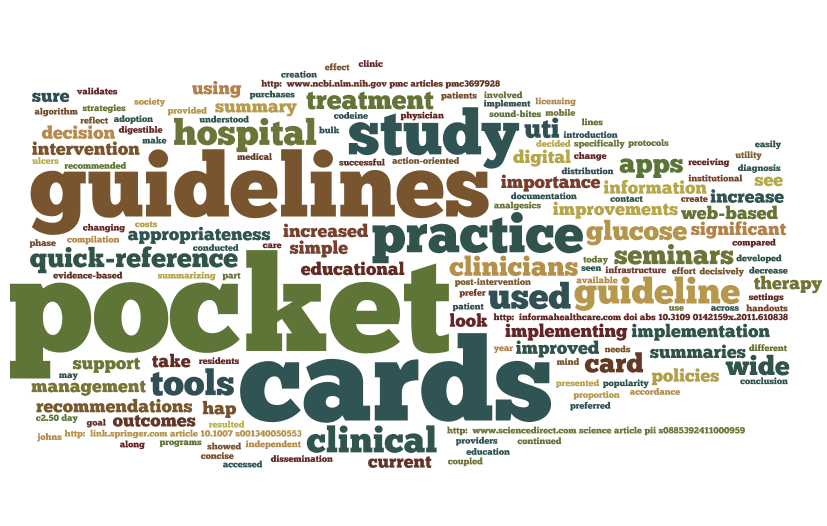
The Importance of Quick-Reference Guidelines: Summaries of Related Studies
If you haven’t seen our clinical practice guidelines infographic, make sure to take a look. Based on the popularity of that blog post, we decided to create another along those lines.
As you may already know, our goal with GUIDELINES Pocket Cards and Apps is improve patient outcomes by making sure clinicians have access to the most current evidence-based guideline information, at their fingertips, in digestible sound-bites that can be easily understood and applied at the point of care. With that in mind, let’s take a look at some recent studies to see the effect of quick-reference guidelines in various healthcare settings…
Here are summaries from current literature validating the importance of quick-reference guidelines – both pocket cards and digital applications.
- http://informahealthcare.com/doi/abs/10.3109/0142159X.2011.610838 -This study showed clinicians preferred simple educational tools for implementing practice change, using seminars, web-based tutorials, handouts, pocket cards and web-based management algorithm. The most frequently used and useful tools were pocket cards (76%) and seminars (76%); 79% continued to use the card. The conclusion: “When provided with different educational tools, clinicians prefer pocket cards and seminars – tools that are simple and readily accessed.”
- http://onlinelibrary.wiley.com/doi/10.1111/j.1365-2710.2009.01045.x/abstract -This intervention study looked at improving antibiotic therapy by changing prescribing practice using treatment guidelines. Specifically there were needs for therapy improvements in UTI and HAP, and the improvements in UTI treatment and HAP diagnosis and treatment were both significant. “The guidelines were presented to the medical residents on a pocket card… In the post-intervention phase 100% of UTI were treated as recommended, compared to 30% before the intervention (P < 0·001).”
- http://www.ncbi.nlm.nih.gov/pmc/articles/PMC3697928/ -This study was conducted at Johns Hopkins Hospital and focused on finding strategies for successful implementation of a hospital wide glucose effort, which involved creation of the policies coupled with education and clinical decision support. As part of the clinical decision support infrastructure, pocket cards were developed and used to assist providers to act in accordance with the recommendations. Here is their summary of the pocket cards: “The pocket cards reflect a concise, action-oriented summary of the hospital wide glucose policies. Distribution of pocket cards summarizing algorithms and protocols during implementation of hospital wide glucose management programs have resulted in improved hyperglycemia outcomes, improved physician adoption of practice guidelines.
- http://www.sciencedirect.com/science/article/pii/S0885392411000959 -This study used a pocket card and achieved significant decrease in % of patients receiving codeine and increase in more appropriate analgesics.
- http://www.ncbi.nlm.nih.gov/pmc/articles/PMC3278963/ -A 2 year study which included pocket cards significantly increased the proportion of identification and documentation of pressure ulcers.
- http://link.springer.com/article/10.1007/s001340050553 -Study that used pocket cards to implement a clinical practice guideline and increase appropriateness: after the introduction of the guideline, appropriateness increased from 75.8 % to 91.1 %, and medication costs decreased from C2.50/day to C1.30/day.
As you can see – this compilation of independent study summaries decisively validates the power and utility of GUIDELINES Pocket Cards and digital apps for implementing guideline recommendations across a practice, clinic, or network.
For more information about having your society’s guidelines available as pocket cards or mobile apps, or for dissemination, bulk purchases or institutional licensing – contact us today.